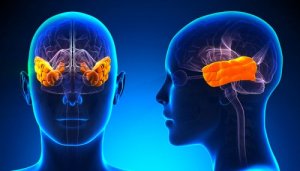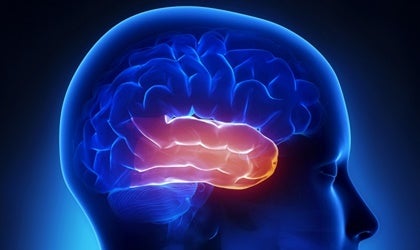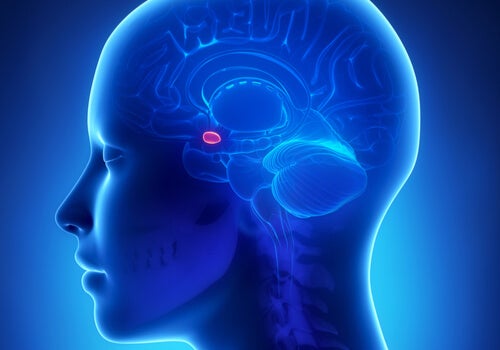Klüver–Bucy Syndrome: The Loss of Fear

Klüver-Bucy syndrome is one of the most extreme examples of how a nervous system alteration can completely change an individual’s way of life.
Imagine that there’s a piece of your brain responsible for the emotions of fear and rejection. Now, imagine that this piece is damaged and you’re no longer afraid of anything. You may be thinking, “Wow, that must be great”, but, in reality, it isn’t. Although no one likes to experience fear, it’s a necessary emotion for our survival.
This fundamental piece is called the amygdala, and its alteration or elimination can lead to Klüver-Bucy syndrome. This syndrome is characterized by the loss of fear and inhibition, causing risky behavior, disordered diet, and dysfunctional sexual activity, among others.
Klüver-Bucy syndrome
Heinrich Klüver and Paul Bucy identified this syndrome, hence its name. The doctors removed the temporal lobes of Rhesus monkeys in order to explore their functions. What they found was quite worrisome. Basically, the alteration of this structure produced the following symptoms:
- Oral behavior. The monkeys had the impulse to explore all objects with their mouths as if it were the only way to do it.
- Hypersexuality. Sexual behavior increased significantly.
- Visual agnosia. They presented difficulties recognizing objects or people through sight.
- Emotional changes. They were very unmotivated and lacked facial expression. Undoubtedly, the most significant emotional change was the loss of fear. A stimulus that at another time would’ve generated terror, didn’t seem to trigger anything in them.
Klüver-Bucy syndrome in humans
Although the symptomatology in humans is quite similar, there are differences. Compulsive and indiscriminate behaviors take special relevance, and there’s a significant alteration in social exchange. Among the main symptoms, we can identify:
- Loss of fear. The subject has the impulse to interact with potentially harmful stimuli that we generally learn to avoid.
- Indiscriminate diet. Not only do they eat compulsively, but they try to feed on dangerous substances, such as plastic or feces.
- Sexual behavior. Sexuality seems to have no limit. These subjects show a great increase in all kinds of sexual activity, with significantly low levels of inhibition.
- Compulsive oral behavior. People with this syndrome tend to examine everything by mouth in a compulsive manner.
- Loss of inhibition. This loss affects all spheres of personality, but it also affects the visual level. These individuals tend to overreact to all visual stimuli as if there was no previous filter.
- No recognition. Subjects lose the ability to recognize friends or family. Consequently, they portray attitudes they would never have if they recognized them.

The loss of inhibition
Fear and rejection are usually described as negative, undesirable emotions. This belief, in addition to being very superficial, is meaningless on a biological and evolutionary level. Fear, rejection, and inhibition are emotions that help us interact with our environment in a functional way.
Behavior alteration
Lacking the ability to interact with others can have very serious consequences, and Klüver-Bucy syndrome is a clear example of that. In fact, it’s the individual’s inability to draw the line between their impulses and actions what seems to produce these symptoms. Moreover, this condition is aggravated by the subject’s inability to recognize the people around them; which in turn incapacitates the person to recover the memory of the emotional bond with their loved ones.
The organic alterations of Klüver-Bucy syndrome
The alterations mentioned above have their etiology in the structural alteration of certain organs of the nervous system:
- Temporal lobe. This lobe is responsible for the processing of language. Additionally, it establishes a link between visual stimuli and their emotional content in memory. Visual agnosia is manifested mainly due to an alteration in this structure.
- Amygdala. The amygdala is a subcortical structure responsible for emotional processing. When a stimulus is threatening, its activation is triggered, leading to the fight or flight response. It’s a fundamental mechanism for the survival of mammals.
- Bundles of white matter. It’s mainly a concentration of axons with the aim of connecting several parts of the nervous system at the subcortical level. Its alteration twists the existing association in memory between stimuli and their emotional content.

Causes of Klüver-Bucy syndrome
The structure alteration mentioned above can have different causes and expressions. Among the most outstanding ones, we can identify:
- Infectious or viral diseases. Herpetic encephalitis and meningitis are the most frequent. The infection or inflammation produced destroys nervous tissue.
- Injuries. For example, traumatic brain injuries usually caused by accidents. Usually, the damage needs to be severe and deep in order to affect subcortical structures such as the amygdala. Surgical injuries can also lead to it.
- Dementia. Klüver-Bucy syndrome is usually related to Alzheimer’s or Pick’s disease, where the degeneration of nervous tissue occurs at the subcortical level and can affect the temporal lobe. In this case, most mental abilities are depleted.
- Tumors. The pressure and metabolic imbalance resulting from a tumor can lead to several symptoms of Klüver-Bucy syndrome. Tumors are usually found in the frontotemporal area.
- Epilepsy. An alteration of the temporal lobes at the electrical level can produce hyperactivation which affects the nervous tissue, mainly the white matter pathways.
- Stroke. Hemorrhage due to effusion or blood loss due to occlusion are also important components in the etiology of this syndrome.
Treatment
Treatment is as difficult as it is limited due to the incapability to recover nerve tissue. Most treatments require pharmaceuticals in order to appease the maladaptive behavioral symptoms.
First of all, the aim of the initial interventions is reducing the impact of the injuries. An example of this is to try to reverse a hemorrhage caused by a stroke. It’s difficult to predict this syndrome given that the consequences of behavior injuries often start out subtle.
In addition, the advances in neuroscience and rehabilitation techniques are improving these patients’ quality of life. Klüver-Bucy syndrome is a clear example of the impact that alterations in the nervous system may have on our daily life. The patient’s loved ones also suffer since they become unrecognizable to them. For the same reason, therapeutic work with family and friends is very important.
All cited sources were thoroughly reviewed by our team to ensure their quality, reliability, currency, and validity. The bibliography of this article was considered reliable and of academic or scientific accuracy.
- Klüver, H. & Bucy, P. (1997). Preliminary analysis of functions of the temporal lobes in monkeys. 1939. J. Neuropsychiatry Clin. Neurosci. 9 (4):606-620
This text is provided for informational purposes only and does not replace consultation with a professional. If in doubt, consult your specialist.








